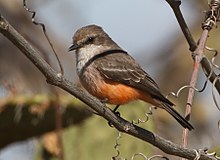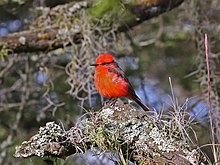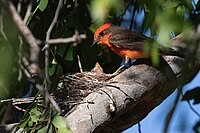Vermilion flycatcher
| Vermilion flycatcher Temporal range:
| |
|---|---|

| |
| Scientific classification | |
| Domain: | Eukaryota |
| Kingdom: | Animalia |
| Phylum: | Chordata |
| Class: | Aves |
| Order: | Passeriformes |
| Family: | Tyrannidae |
| Genus: | Pyrocephalus |
| Species: | P. obscurus
|
| Binomial name | |
| Pyrocephalus obscurus Gould, 1839
| |
| Subspecies | |
|
See text | |

| |
| Range map[2]
Year-round
Breeding
Nonbreeding
| |
The vermilion flycatcher (Pyrocephalus obscurus) is a small passerine bird in the tyrant flycatcher family found throughout South America and southern North America. It is a striking exception among the generally drab Tyrannidae due to its vermilion-red coloration. The males have bright red crowns, chests, and underparts, with brownish wings and tails. Females lack the vivid red coloration and can be hard to identify—they may be confused for the Say's phoebe. The vermilion flycatcher's song is a pit pit pit pidddrrrreeedrr, which is variable and important in establishing a territory. Riparian habitats and semi-open environments are preferred. As aerial insectivores, they catch their prey while flying. Their several months-long molt begins in summer.
Despite being socially
The species was first
Taxonomy and systematics

The
The first
The genus name Pyrocephalus is
Subspecies

Before 2016, authors had recognized between 11 and 13 subspecies (sometimes called races). A 2016 molecular study revised that to nine subspecies, made two others their species (P. nanus—Darwin's flycatcher, P. dubius—San Cristóbal flycatcher, P. rubinus—scarlet flycatcher), and determined that another was not valid (P. major). Some works still refer to the vermilion flycatcher as Pyrocephalus rubinus, which can lead to confusion with the scarlet flycatcher (also called Pyrocephalus rubinus).[8][9][12] The vermilion flycatcher likely evolved around 1.15 million years ago (mya), the species on the Galápagos Islands having split off around 0.82 mya. The South American subspecies had coalesced by about 0.56 mya, and the North American subspecies had diverged from the South American by 0.25 mya.[8]
There are nine widely recognized subspecies, which differ primarily in the color and
- P. o. obscurus (Gould, 1839)—The Lima region of western Peru.[9]
- P. o. mexicanus (Sclater, 1859)—Found from southern Texas in the United States south to central and southern Mexico.[9] Its upperparts are the blackest of any race, and the male lacks any mottling on the red parts.[2] This subspecies is named after Mexico.[11]: 252
- P. o. saturatus (von Berlepsch and Hartert, 1902)—Found in northeastern Colombia, western and northern Venezuela, Guyana and northern Brazil.[9] The female has pink underparts.[2] Saturatus means "richly colored" in Latin.[11]: 54
- P. o. blatteus (Bangs in 1911)—Found in southeastern Mexico, Belize and northern Guatemala.[9] The upperparts are paler, and the underparts more red compared to the nominate race, lacking an orange tinge. It is also smaller than the other Mexican races.[2] Blatteus means "purple colored" in Latin.[11]: 73
- P. o. flammeus (van Rossem, 1934)—Found in the southwestern United States and northwestern Mexico.[9] The upperparts are paler and slightly gray, and the underparts are more orange colored than the nominate race. Males may also have orange mottling in the crown and breast, whereas the females are less streaky.[2] Flammeus means "flame colored" in Latin.[11]: 54
- P. o. ardens (Cajamarca, and Amazonas.[9] Their coloration has been described as "fiery red". The front of the females crown is slightly pink.[2] Ardens means "burning" in Latin.[11]: 54
- P. o. cocachacrae (Zimmer, 1941)—Found from southwestern Peru south to extreme northern Chile.type locality is the Cocachacra District in Peru.[2]
- P. o. piurae (Zimmer, 1941)—Found from western Colombia south to northwestern Peru, it is named for the Piura province in Peru.[9][11]: 309
- P. o. pinicola (Howell, 1965)—Found in eastern Honduras and northeastern Nicaragua.[9] It is smaller than P. o. blatteus, and the females have more orange underparts. It prefers pine savanna habitats, which is reflected in the name Pinicola: it roughly translates to "pine tree dweller" from Latin.[2][11]: 307
Description

The vermilion flycatcher is a small bird, measuring 13–14 cm (5.1–5.5 in) from tip to tail, around 7.8 cm (3.1 in) from wingtip to body, with a mass between 11 and 14 g (0.39 and 0.49 oz).
Worn feathers are replaced by molting, which takes between 62 and 79 days and begins in July, lasting until September. Many vermilion flycatchers molt only after completing their migration to warmer regions. The molt is fairly slow compared to that of other families, as quick molting creates poor feathers and interrupts flight, which is untenable for an aerially feeding species. A 2013 study determined that monsoon rain patterns do not affect molting, as had been previously expected. Instead, latitude-based temporal effects are more important in timing the molt.[15]

Vocalizations
Ornithologist David Sibley describes the perching song as a pit pit pit pidddrrrreedrr,[16] whereas the Cornell Lab of Ornithology describes it as a ching-tink-a-le-tink, with an emphasis on the last syllable.[2] The flight song is given by males who fly high above the canopy, and is described as a pt-pt-pre-ee-een by the Cornell Lab. The regular song may also be given as a slower chatter call. Other noises include a pees noise that is given as a call. A peent is given while foraging, but a more aggressive variety is also used between males. As a lead-up to copulation, the female may give a tjee-tjee-tjee call.[2][16]
The call of the vermilion flycatcher is important in establishing its territory. Males make only a single song while perching, but can alter the song to convey different intentions. The male's song consists of a variable first part, and a second part with four elements. The first part of the song gets longer after nest construction, and before dawn. The first part encodes information regarding the quality of the male to potential mates and the level of threat to other males—which is related to the intensity with which males defend their territory.[17] Females do not usually sing.[18] Urban noise pollution appears to affect songs; a population in Mexico City was found to sing louder and longer songs as ambient noise increased.[19] Singing is not heard year-round; populations in Arizona and Texas sing only from late February through July.[2]
Non-vocal sounds include snapping the beak, by males between songs and by females while watching male courtship flights. Their wings may also be used to create a whirring noise while perch hopping or during territorial displays, though this is practiced infrequently.[2]
Distribution and habitat
Their range includes almost all of Mexico, extending north into the
Vermilion flycatchers prefer somewhat open areas and are found in trees or shrubs in savanna, scrub, agricultural areas,
Behavior
Vermilion flycatchers are generally solitary, though they may form small flocks of not more than five individuals during winter. They spend most of their time in trees perching, landing on the ground only rarely to catch insects. They do not generally hop, preferring to fly to get around, and
Breeding and nesting
Vermilion flycatchers are socially

Males then choose a nesting site, and females begin construction. The vermilion flycatcher's nest is a shallow cup made of small twigs and soft materials, lined with feathers; the nest's rim is often covered with lichen. Spiderwebs may be used to bind the nest together. Females use a rocking motion of their body to shape the nest during construction. Even after construction, the female will continue to add insulating material, such as plant materials, hair, fur, or man-made materials like string. Average nest sizes are about 64–76 mm (2.5–3.0 in) across, 25–51 mm (0.98–2.01 in) tall, and with a cup depth of less than 25 mm (0.98 in).[2] Nests are typically located within 6 ft (1.8 m) of the ground; the nest is placed in the horizontal fork of a tree branch. About 12% of nests are reused, and old nests may be raided for materials for new nests.[22]
Egg-laying begins in March and runs through June; eggs are laid once a day in the early morning. Eggs are ovate and approximately 17 mm (0.67 in) × 13 mm (0.51 in). They average 1.6 g (0.06 oz) in weight, which is about 11% of the female's body mass. They are a dull whitish color and have large brown splotches in a wreath pattern on the larger end, though egg coloration varies. Spotting may be more intense, and the base color may be creamy or even tan or brown. Clutches usually contain two or three eggs but may occasionally include up to four.
-
Male at nest
-
Nestlings, who have yet to hit their first juvenile molt
Feeding

The vermilion flycatcher feeds mostly on insects such as
Survival
The predators of the vermilion flycatcher are not well known. Unusual reports of predation include by a
Several
Although the diseases of the vermilion flycatcher are not well studied, the diseases of the birds of the Galapagos are known, and these diseases may have affected the closely related San Cristóbal flycatcher. Introduced and destructive diseases include
Relationship to humans
The vermilion flycatcher is a favorite with birders, but it is not generally kept in aviculture as the males tend to lose their vermilion coloration when in captivity.[29] This is likely a diet-based effect, as maintaining bright red coloration in birds requires substantial quantities of yellow precursor zeaxanthin molecules which are then metabolized into red pigment. This acts as an indicator of genetic fitness to potential mates, as a bright male is using his diet-based coloration to show off his ability to survive and catch food.[30][31]
The
Status
Because of its enormous range and sizable population—with a population estimated ranging between 5,000,000 and 50,000,000 individuals—the vermilion flycatcher is listed as a species of
The San Cristóbal flycatcher, which was once considered part of the species, was endemic to the Galápagos Islands but went extinct sometime between 1987 and 2012.[33][34] The Darwin's flycatcher, which was also once part of the species, is considered a vulnerable species by the International Union for Conservation of Nature.[35]
References
- ^ a b BirdLife International (2021). "Pyrocephalus rubinus". IUCN Red List of Threatened Species. 2021: e.T103682912A187307157. Retrieved April 12, 2023.
- ^ from the original on September 6, 2020. Retrieved April 15, 2020.
- ISBN 84-87334-69-5.
- Smith, Elder and Company. p. 44. Archivedfrom the original on August 17, 2019. Retrieved April 15, 2020.
- ^ "ITIS Report: Pyrocephalus". Integrated Taxonomic Information System. Archived from the original on October 10, 2015. Retrieved November 26, 2014.
- ^ Gray, G. (1840). A List of the Genera of Birds : with an Indication of the Typical Species of Each Genus. Vol. 8. London: R. and J.E. Taylor. p. 30. Archived from the original on August 17, 2019. Retrieved April 15, 2020.
- ^ Traylor, Melvin A. Jr, ed. (1979). Check-list of Birds of the World. Vol. 8. Cambridge, Massachusetts: Museum of Comparative Zoology. pp. 149–150. Archived from the original on August 17, 2019. Retrieved April 15, 2020.
- ^ PMID 27233443.
- ^ ISBN 84-87334-69-5.
- ISBN 9780520274938. Archivedfrom the original on October 2, 2020. Retrieved May 14, 2020.
- ^ S2CID 82496461. Archived from the original(PDF) on August 15, 2019. Retrieved August 20, 2019.
- ^ Gill, F.; Donsker, D., eds. (2019). "Tyrant flycatchers". World Bird List Version 9.2. International Ornithologists' Union. Archived from the original on December 29, 2019. Retrieved August 17, 2019.
- ^ "Vermilion Flycatcher – Bold Red and Beautiful". The Spruce. Archived from the original on October 2, 2020. Retrieved September 27, 2020.
- ^ OCLC 52204513.
- ISSN 0004-8038.
- ^ OCLC 869807502.
- S2CID 49420116.
- ^ from the original on July 20, 2020. Retrieved April 14, 2020.
- S2CID 17055748.
- ^ (PDF) from the original on December 4, 2014. Retrieved November 28, 2014.
- (PDF) from the original on December 4, 2014. Retrieved November 28, 2014.
- LCCN 06-23231.
- ^ National Audubon Society. Archivedfrom the original on April 10, 2019. Retrieved April 10, 2019.
- ^ from the original on June 4, 2020. Retrieved June 14, 2020.
- (PDF) from the original on November 29, 2011. Retrieved January 25, 2008.
- (PDF) from the original on October 2, 2020. Retrieved November 28, 2014.
- JSTOR 26267654.
- (PDF) from the original on November 3, 2018. Retrieved June 14, 2020.
- ^ "Vermilion Flycatchers". Beauty of Birds. Archived from the original on March 16, 2015. Retrieved April 16, 2020.
- PMID 27212400.
- PMID 27825451.
- Audubon Society. Archivedfrom the original on February 23, 2020. Retrieved April 14, 2020.
- ^ "The First Bird Extinction in Galapagos". Durrell Wildlife Conservation Trust. 2016. Archived from the original on October 2, 2020. Retrieved April 14, 2020.
- ^ Martin W., Johannes F., Hernan V. & Howard S.: Galápagos Birds and Diseases: Invasive Pathogens as Threats for Island Species (PDF full text Archived May 16, 2008, at the Wayback Machine, 384 KB) 2004
- . Retrieved May 24, 2020.
External links
- "Vermilion flycatcher media". Internet Bird Collection.
- Species account—Cornell Lab of Ornithology
- Vermilion flycatcher—Pyrocephalus rubinus—USGS Patuxent Bird Identification InfoCenter
- Stamps[usurped] at bird-stamps.org
- Vermilion flycatcher photo gallery at VIREO (Drexel University)
- Interactive range map of Pyrocephalus rubinus at IUCN Red List maps





